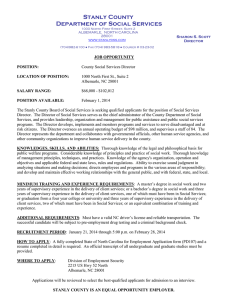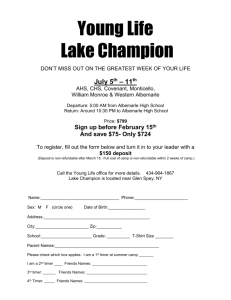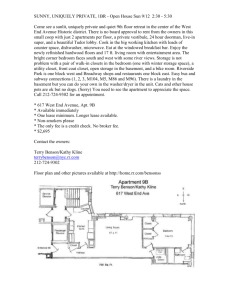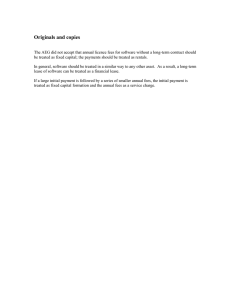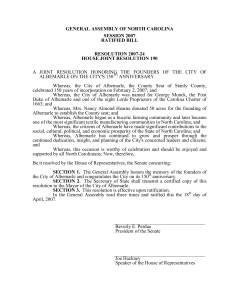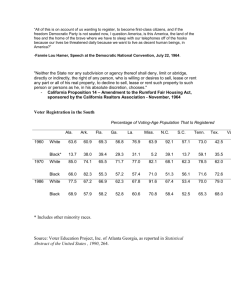History of the Ri site and buildings
advertisement
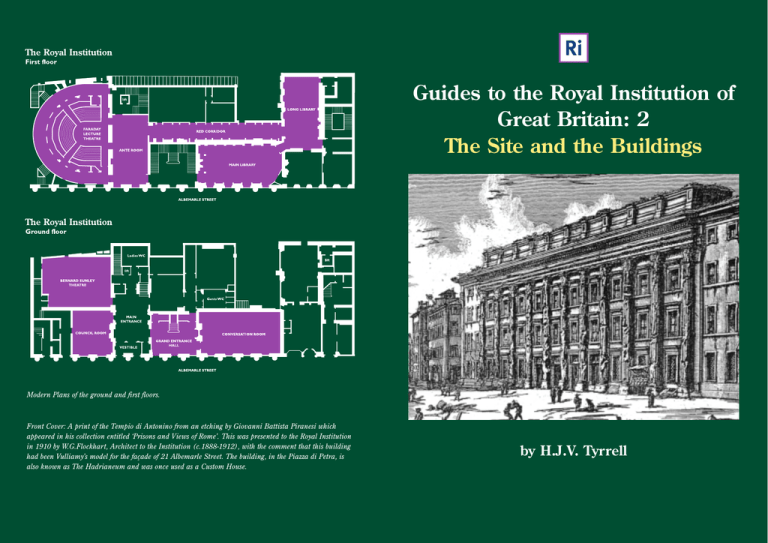
Guides to the Royal Institution of Great Britain: 2 The Site and the Buildings Modern Plans of the ground and first floors. Front Cover: A print of the Tempio di Antonino from an etching by Giovanni Battista Piranesi which appeared in his collection entitled ‘Prisons and Views of Rome’. This was presented to the Royal Institution in 1910 by W.G.Flockhart, Architect to the Institution (c.1888-1912), with the comment that this building had been Vulliamy’s model for the façade of 21 Albemarle Street. The building, in the Piazza di Petra, is also known as The Hadrianeum and was once used as a Custom House. by H.J.V. Tyrrell T he Royal Institution was founded at a meeting of a group of influential men held on 7 March 1799 at the Soho Square house of the President of the Royal Society, Joseph Banks (1743-1820). They resolved to ‘form by subscription in the Metropolis of the British Empire a Public Institution’ to further ‘the application of science to the common purposes of life’. The proposals for this institution had been drawn together in the previous weeks by Benjamin Thompson, Count Rumford (1753-1814). The meeting approved these proposals and elected a committee of Managers to run the new Institution. Hounslow Heath in April 1798. Rumford and Bernard were favourably impressed by its possibilities and the Managers then asked the architects Henry Holland (c1746-1806) and John Soane (1753-1837) to examine its condition. Also at that meeting Rumford and Thomas Bernard (1750-1818), a wealthy barrister and philanthropist, were commissioned to search for a suitable home for the infant Institution. That needed to be in a convenient location and sufficiently commodious to act as a meeting place for subscribers and where lectures and demonstrations could be held. During the eighteenth century a district lying between Piccadilly and Oxford Street had been developed as a fashionable residential district with a number of large houses, and the search began (and ended) there. They reported favourably on the condition of the building and suggested a price for which it might reasonably be obtained. The Managers agreed to proceed on the basis of that report and, after some negotiation, a price of £4850 was agreed for the house, and for associated leasehold interests. These were (and are) substantial and have had important influences on the later history of the Institution. Although the first meeting of the Managers was held in No. 21 as early as 5 June 1799, final negotiations were still proceeding since the deed of conveyance is dated 29 August 1799 and the eventual terms were not agreed until mid-September. The house was unusual in form in that it was only one room deep with a site frontage, including a small garden at the north end, of over one hundred and forty feet to Albemarle Street. These features made it quite unlike its immediate neighbours, Nos. 20 and 22, and they reflect its early history as an extension to No. 20. A property in New Bond Street, originally built for Charles Fitzroy, 2nd Duke of Grafton (1683-1757), had become available following the death of a later occupant, John Hobart, 2nd Earl of Buckinghamshire (1723-1793). It was the first to be inspected by Rumford and Bernard who reported favourably on its location and suitability. However, the Managers felt that the available funds were insufficient to meet the proposed annual rental of 400 guineas. A nearby house, 21 Albemarle Street, was then considered. It was owned by a Trust set up under the Will of William Mellish (c.1710-1791), once MP for Grimsby and later a Commissioner of Excise, and was on the market following the death of John Mellish, one of William’s sons. He had lived there since his father died and had been killed by a highwayman on No. 20 had been built between 1703 and 1705 on a freehold plot at the corner of what was, at that time, the extreme northern end of Albemarle Street laid out at the end of the seventeenth century, along with Dover, Stafford and Bond Streets, by a development syndicate on a block of freehold land immediately north of Piccadilly. That land had been the site of a great house, known first as Clarendon House and later as Albemarle House, commissioned in 1664 by Edward Hyde, Earl of Clarendon (1609-1674), then the Lord Chancellor. He had also obtained from the City of London a 99 year lease from 1668 on a substantial block of land (the Conduit Mead estate) immediately to the north of his freehold, intended to provide a park worthy of his mansion. The boundary between his freehold 2 3 and leasehold holdings was a medieval field boundary between Conduit Mead and a field called Penniless Bench upon which his house had been built. Figure 1 shows that boundary superimposed upon the modern street pattern. Sadly for Clarendon, he lost favour with Charles II (1630-1685), was dismissed from office, fled to France at the end of 1667 to avoid imprisonment and never returned. After his death his son Henry Hyde, the 2nd Earl (16381709), sold the house and the lease to Christopher Monck, 2nd Duke of Albemarle (16531688), who later sold the whole estate to the syndicate. As part of the overall development plan the developers had also constructed a road connecting Figure 1. Street plan with field boundaries superimposed. Bond Street with Hay Hill along the boundary of the freehold land on the leasehold property to the north. This road was to be the southern boundary of a planned Albemarle Square, never to be realised because of the financial failure of the developers. Their failure meant that, when the young Henry d’Auverquerque, Earl of Grantham (c.1672-1754), the first owner of No. 20, took up residence in his new house it faced towards open country to the north across the "new" road and west 4 across Albemarle Street. Fortunately for Grantham and other freeholders in the vicinity, four acres forming part of the old Clarendon lease which lay west of Bond Street, immediately north of and adjacent to their properties, came up for sale in 1707. A group formed from Grantham and his neighbours bought it and then divided it among themselves. In 1709 the group obtained a writ permitting the road built by the developers to be moved northward, first by about 90 feet and then, with a second writ in 1723, up to the present line of Grafton Street with the consequent extension of Albemarle Street to the north. Therefore, No. 20 ceased to be a corner house after 1709 and Grantham, with his own share of the leasehold land, was able to build the extension shown in Rocque’s 1746 map of London with a frontage of 76 feet along the extended Albemarle Street. That distance from the party wall between Nos. 20 and 21 extends to the North wall of the present Grand Staircase and we can therefore easily recognise the original core of what became 21 Albemarle Street. The extension to No. 20 was certainly constructed after 1709 and before 1746 but it may have existed, at least in part, Figure 2. Plan showing the complex subdivision of Roberts’s lease. 5 before 1723, the date when Grantham and his fellow lessees obtained the writ which allowed them to move Grafton Street to its present position. Figures 2 and 3 show, respectively, the outline and dimensions of Grantham’s leasehold, and the built-up part of Grantham’s property in about 1760 soon after Grantham’s death in 1754 and the subsequent separation of Nos. 20 and 21 into separate private residences. Grantham left no heir and his executors disposed of the property to John Roberts (d.1772), of whom little is known, and William Mellish. The process of separation seems to have taken place during 1756 and 1757 and clearly a good deal of internal reorganisation was necessary, especially in No. 21, before two independent households Figure 3. Plan of 20 and 21 Albemarle Street after the separation. Also shows the Bond Street town house of the Duke of Grafton and Earl of Buckinghamshire. 6 could be established. In particular, there would have been no need for a main stair in Grantham’s original extension since a particularly splendid cantilevered one, which still exists although currently in a sadly decayed setting, was already present in the main house. The present Grand Staircase in No. 21 is dated stylistically at around 1756, a date which fits perfectly with the known period of separation of the two houses, and was presumably inserted into a space occupied by rooms on the ground and first floors at that end of the existing building. To reach the second and third floors it would have been necessary to utilise the service stair, shown on the ground plan in Figure 3, which ran from the basement up to the third floor; most of this stair was moved eastward towards the rear of the site after the Royal Institution began to modify the private house for its own purposes but the original section connecting the second and third floors remains to this day. As can be seen from Figure 3, Mellish, a married man with four children, lived in the more spacious No. 20 as Roberts’s tenant while Roberts, apparently a bachelor, took over No. 21. It is likely that the basement kitchen and other domestic facilities, which existed in the rear garden area when the Royal Institution took over the house, also date from this period of separation. Roberts as the recorded owner of the residue of the original lease was faced, as were other owners, with its imminent expiry in 1767. After considerable internal discussions the City decided to issue leaseholders with what were essentially ‘copyhold leases’. These were issued either for 40 or for 61 years, less one quarter, and were perpetually renewable, for the same term, at 14 yearly intervals on payment of a lease renewal fine. If the fine was not paid at the due time, the City of London could refuse to renew the lease which would eventually revert to the freeholder. Roberts’s lease, on the plot shown in Figure 2, required a ground rent of £150 per annum with a lease renewal fine of £600, the first renewal being due in 1781. There were no provisions for the review of either the annual rental or of the 7 renewal fine. This system prevailed on the Conduit Mead estate up to just beyond the lease renewal date of 1921. Legal changes in property rights during 1924-1925 forced the City of London to replace these leases and, after much discussion culminating in a judicial review, the Royal Institution in common with similar leaseholders was granted a term lease for 2000 years from Michaelmas 1921. The rental was set at the original figure apart from a small addition based on the fact that no further lease renewal fines needed to be paid. There was no provision for rent reviews and the Royal Institution’s leases became virtual freeholds subject to rentals which are negligible by present standards. With his new lease Roberts was then free to plan to extend No. 21 northward, apparently by about 30 feet, and to dispose of most of the northern section of his garden by issuing a perpetually renewable building lease to a developer, Edward Gray, who also had a similar underlease from Augustus Henry Fitzroy, 3rd Duke of Grafton (17351811) on the corresponding plot facing Bond Street. When allocating sub-leases for building plots Gray tended to ignore the precise boundaries between these two underleases, a habit which led to anomalies, one of which, relating to 22 Albemarle Street, later forced the Royal Institution to acquire the head lease on the land originally leased to Gray by the Duke of Grafton and to become, nominally at least, a substantial Mayfair landlord. But that is another story. Roberts died before these plans could be fully realised. Mellish moved out of No. 20 and sold it on behalf of Roberts’s sisters, who were the heirs, and acquired No. 21 from them on condition that he fulfilled the contracts into which Roberts had already entered. By the time the Institution bought No. 21 from the Mellish family the planned extension was in existence and the ground floor of the house had the form shown in Figure 4. No. 22, fronting on to Albemarle Street, and the original No. 23 (demolished and replaced 8 Figure 4. Ground floor plan of 21 Albemarle Street when first purchased by the Royal Institution. in 1896), situated on the corner of Albemarle and Grafton Streets, had by then been built by developers, including Gray, who had been granted building leases, first by Roberts and later by Mellish. These two houses produced a rental income of £122 p.a. and a total of lease renewal fines of £610. Hence, by purchasing the lease on No. 21, the Managers had acquired a home and, in addition, became the ground landlord for properties which were producing an income which paid all but £28 p.a. of the rental due to the freeholder, and gave the prospect of making a small profit of £10 on each lease renewal date. When the Royal Institution bought the property it was thus a dwelling house, one room deep with a long frontage to Albemarle Street and open ground at the rear apart from basement kitchens at the southern end as is shown in Figure 4, which is probably based on the accurate survey in March 1800. Unfortunately there is no direct evidence concerning the appearance of the Albemarle Street elevation but certain indirect deductions can be made. The front of No. 20 is essentially unaltered with its plain brick front relieved by a Portland 9 stone string course and cornice and, since No. 21 was an extension, it is almost certain that the front would have matched that of No. 20. This is confirmed from the specification for the considerable alterations required to fit the old house for its new purpose. Thomas Webster (c1772-1844), a young Orcadian, was employed by Rumford as Clerk of Works to collaborate with him in preparing sketches and designs for the necessary changes. Webster wrote the specification for the changes and mentions that the new building work required should match the front of the old house with its ‘Portland stone cornice and string course’. Rumford originally expected Webster to design the alterations unaided but on 21 March 1800 the Managers appointed a surveyor and life subscriber named James Spiller (d.1829) to produce an accurate survey and to collaborate with Rumford in preparing sketches and designs. He presented his report with plans and elevations on 21 April and was asked to prepare cost estimates. However at the meeting of Managers on 12 May it was reported that the architect George Saunders (1762-1839) had offered to take the task over without fee, a proposal that Rumford and the Managers could not resist, and Saunders was immediately appointed Surveyor to the Royal Institution in succession to Holland and Soane. In spite of these changes, little time was lost since the design was finalised and a building contract was let by 26 May. The plans required the demolition to the first floor level of part of the Roberts-Mellish extension at the north end of the house and the utilization of the small garden area which remained up to the boundary with No. 22, in order to create the Lecture Theatre. Completed in 1802 this remained in use until it was declared unfit in 1928 by inspectors from the London County Council and was then replaced by the present Theatre, modelled closely on the original but built to modern standards of safety and fire protection. Below the Theatre was a room with a double row of columns across its centre supporting the floor of the Theatre, which was originally used for the display of models and ‘useful mechanical contrivances’. The Bernard Sunley Theatre, opened in 1970, now occupies the site and 10 one of the columns still remains because of the great cost which would have been involved in its removal. Where the Council Room is now sited there was a room furnished for the convenience of Members as a Conversation Room where simple refreshments could be served. A new but cramped service staircase from the basement to the second floor was constructed behind the original one, using much of the material from it, thereby freeing space in which a Secretary’s Room, occupying part of the present entrance hall, had been created by 1808. The original entrance, formed after the separation of Nos. 20 and 21, had been opposite the foot of the Grand Staircase and was retained until the reconstruction in 1928-1930 when the present main entrance was formed where the Secretary’s Room had been since 1808. The other major development at that time was the construction of a wing at basement and ground floor level eastward from behind the Grand Staircase out to the site boundary with an adjoining top-lit basement room, possibly related to the original house kitchen, on Figure 5. Plan of the ground floor from about 1808 to 1838. 11 the south side, to form the Chemistry Laboratory of Humphry Davy (1778-1829) and Michael Faraday (1791-1867). This wing is shown in Figure 5 though with the internal arrangements corresponding to those existing in 1808. The basement floor of the new wing was originally fitted out as a Public Kitchen to demonstrate Rumford’s theories of how such kitchens should be run. The ground floor was at first divided into two rooms, one for the use of the Managers and the other as a Dining Room where the products of the Kitchen could be sampled by Proprietors and Subscribers. This arrangement did not long survive Rumford’s departure in 1802. By 1808 the Public Kitchen had been fitted with seats and converted into a lecture room opening into the Chemistry Laboratory, thus making it easy to provide experimental demonstrations to an audience. The two small rooms on the ground floor of the extension had been thrown into one and fitted up to display Davy’s mineralogical collection. The two Figure 7. The Main Library on the first floor in 1809. Figure 6. The Old Library on the ground floor (now the Conversation Room) in January 1923. 12 ground floor rooms of the original house to the right of the Grand Staircase were not initially altered. That nearest to the Hall was used for the reading of foreign newspapers, and the other as a temporary Library. In about 1866 the partition between these rooms was removed together with the old staircase leading from the hall to the basement to form what became the Old Library (Figure 6) and, after further changes in 1935, became the present Conversation Room. The single large room above was initially used as a temporary lecture room, but afterwards was fitted with bookshelves and a gallery for reaching the upper shelves, as illustrated in the Rudolf Ackermann (1764-1834) print from the Microcosm of London published in 1809 (Figure 7) to form the main Library, which remained essentially unchanged until the acquisition of No. 20 in 1896. The rooms above the Library and the Grand Staircase on the second floor were retained as residential accommodation and still form part of the Director’s apartment. Before the main works 13 were completed the roof over the southern portion of the building was raised to the level of that over the northern section, thus equalising the front elevation and providing additional attic bedrooms, intended by Rumford for the accommodation of artisan staff, who were to be boarded and lodged, employed in the Workshops, and trained in an Evening School, all on the premises. Rumford’s departure in 1802 meant that this scheme never came to fruition, and these rooms were used to accommodate members of the staff, including at various times Davy, William Thomas Brande (1788-1866) and Faraday. The construction of both the main Lecture Theatre and of this wing extension out to the boundary with his garden provoked the Duke of Grafton, who still held the headlease on land from the east boundary of the Institution’s property out to Bond Street, to protest to the Managers but without effect. A more long-standing problem for the Institution was that a small area of garden adjoining No. 20, together with some cellars and vaults at that end of No. 21, had been leased in 1784 to the purchaser of No. 20, apparently as part of the agreement for its sale after the death of Roberts. That lease was perpetually renewable at a peppercorn rent and had to be transferred to the new owners whenever No. 20 was sold. This hindered the logical redevelopment of the basement of No. 21 for the purposes of the Institution until Nos. 20 and 21 were reunited in 1894-1896. After the initial changes the next major alteration came in 1838 when Lewis Vulliamy (1791-1871) changed the fenestration and the brick front of the eighteenth century house, as extended by the Institution, to the present rendered neoclassical front with 14 threequarterround Corinthian columns stretching from ground level up to the third floor, apparently inspired by the Tempio di Antonino, Rome (front cover). This front has no structural significance but was intended to emphasise the importance of the Institution; it has 14 certainly succeeded in achieving that objective although the design was heavily criticised in some quarters at the time. There was much rebuilding at the rear of No. 21 in 1872-1873 under John Tyndall (1820-1893) which involved major changes. The Chemical Laboratory of Davy and Faraday had been enlarged in 1863 by removing the seats from the basement lecture theatre. Tyndall, with some regrets, found it necessary to enlarge it further towards the north and to modernise it completely leaving no trace of the famous original which had undoubtedly outlived its purpose by then. In a Discourse of 1873, the Treasurer of the Royal Institution, William Spottiswoode (1825-1883), regretted the loss but described that Laboratory (Figures 8 and 10) as ‘probably the very worst, and certainly all but the worst, Chemical Laboratory in London’. The ground floor room which had contained Davy’s mineralogical collection became a Physics Laboratory with two new small rooms Figure 8. The basement chemical laboratory in 1819. 15 opening out on the south side. The back staircase was rebuilt on a larger scale, a lift installed and a former dummy door in the Lecture Theatre to the right of the lecturer was opened out on to the new staircase. None of these alterations now remain after the substantial rebuilding of No. 21 in 1928 and again in 1935. The first of these was rendered necessary after an explosion in a main electric supply cable in Albemarle Street one evening in December 1927 which shattered the lower windows in the Albemarle Street front and led to detailed inspections of the building. These showed the serious dangers, particularly from fire, inherent in the changes which had taken place since its purchase by the Institution. As a result, much of the northernmost end of the building was, apart from the front, taken down to the basement level and replaced by a modern construction in steel and concrete. At the same time, along most of its length, the building was extended back to the eastern site boundary giving increased accommodation on all floors and modern standards of construction. The present main entrance, with its vestibule protecting the entrance hall, was placed where the Secretary’s Room had been for so long. The hall itself was enlarged eastward by replacing the stair and lift, created by Tyndall, by a new staircase and lift from the basement to the third floor of the new extension. This change gave better access to the third floor and to the Lecture Theatre, and, with the construction of the new corridor behind the Grand Staircase and the Main Library, greatly improved the circulation pattern on the first floor. A little later, in 1935, cracks appeared in the Director’s accommodation on the Albemarle Street side above the main library which necessitated the insertion of a steel frame into that section of the building. During these major reconstructions the fine plasterwork in the then newly created entrance hall, the Grand Staircase, and in the ceiling of the Library, was introduced ‘to preserve and extend the Adam style of which the existing Staircase Hall was such a fine example’ as a Building Committee Minute of December 1929 put it. 16 Figure 9. The Main Library in May 1899, looking South, after Nos. 20 and 21 had been linked. The Grand Staircase was strengthened and the Conversation Room remodelled to its present form. The transformation of the Library by these changes can be seen by comparing its present appearance with the photograph of its appearance before the reconstruction, as seen in Figure 9. Since 1895 the Royal Institution has occupied both 20 and 21 Albemarle Street. The acquisition of the freehold of No. 20 came about through the generosity of Ludwig Mond (1839-1909) who had made his fortune in the chemical industry and whose company, Brunner Mond, eventually formed an important part of Imperial Chemical Industries. He was anxious to support the research effort of the Institution by a substantial endowment to the laboratories, and the provision of more space for its activities. It happened that in 1893 No. 20 was unoccupied and came on to the market. Mond bought it for £20,000 and presented it to the Institution with the proposal that 17 the research activities should be subsumed under the title of The Davy-Faraday Research Laboratory. That generous action allowed the two houses to be rejoined after 140 years of separation. All those with a sense of historical continuity might care to remember that, as they pass between the two houses, they are crossing a medieval field boundary, that between Conduit Mead and Penniless Bench. During the separation No. 20 had an interesting but chequered history. After the separation Mellish occupied the house until the death of Roberts in 1772. It was then sold in 1775 to Thomas Powys (1743-1800), an MP, who lived there until his death, having been created Baron Lilford in 1797. By his Will his widow Mary, Dowager Lady Lilford (d.1823), was left the house in trust for her lifetime if she wished to live there. She was not pleased by the arrival of the Royal Institution in No. 21 and the building operations which followed, in spite of efforts by the Managers to appease her by issuing her and her three daughters with tickets of admission to the lectures. She moved near Portman Square and the house was bought in 1803 by the Rev. John Robinson (1754-1832) for £5,500. Born John Freind and educated in Oxford he entered the Church of Ireland, becoming Archdeacon of Armagh in 1786 before changing his name to Robinson. He was created an Irish Baronet in 1819 and his Will shows him to have been a wealthy man, with a house in County Louth as well as No. 20, his London home, where he died. It then ceased to be a private house since the freehold was bought by John Gurr Chaplin in 1833 as an extension to the long-established Clarendon Hotel in New Bond Street. This occupied the buildings along New Bond Street, shown in Figure 3, which had originally formed the town house of the Dukes of Grafton and later of the Earl of Buckinghamshire, the first house to be seen by Rumford and Bernard. Chaplin had term leases on these and was running one of the best hotels in London of the period. After his death in 1837 the hotel continued to trade successfully and expanded further by later 18 taking a lease on No. 19 Albemarle Street until the business failed and went into receivership in 1866 under Charles Grillion who had formerly controlled Grillion’s Hotel at 7 Albemarle Street. The house then reverted to private occupation once more since it was bought in 1867 by Henry Richard Charles Wellesley, Earl Cowley (1804-1884), who had just returned from a lengthy period as British Ambassador in Paris. He found it necessary to make some extensive alterations, one of which appears to have been on the first floor. A surveyor’s report of July 1867 describes the first floor as consisting of four rooms; currently there are only three. The most likely explanation is that the Long Library formerly consisted of two rooms separated at the point where two pillars now stand. Cowley died in No. 20 in July 1884 and his widow, Olivia (1807-1885), also died there in the following April. They had clearly remained in residence in part of the house in spite of the fact that, in 1883, the New Oxford and Cambridge Club had taken a tenancy and had arranged alterations and additions as is witnessed by amendments to the insurance certificate originally issued to Cowley. Ten years later, the Club left No. 20 and Mond was able to buy it. After the gift, Nos. 20 and 21 were reconnected at the basement, first, second and third floor levels, with Mond paying for the two connecting doors made between the main Library in No. 21 which lead, respectively, into the two interconnecting rooms in No. 20. The Institution paid for the carpeting, furnishing and the fittings of these rooms. The Resident Professor, James Dewar (1842-1923) was allocated three rooms on the second floor of No. 20 as an extension to his apartment in No. 21, partly because of the anxiety expressed by the Managers about the dangers of leaving No. 20 unoccupied at night. This allocation carried an unexpected consequence since Dewar received a quarterly parochial rate demand in April 1897 for £84 on the assumption that he was the sole resident of No. 20. This was remedied by issuing the Resident Professor with an annually 19 time the major rebuilding programme in 21 Albemarle Street enabled the Laboratory to give up the ground floor and part of the basement of No. 20. This accommodation was then leased for forty-two years to Cartier, the jewellers, as an extension to their Bond Street shop with a connection at basement level. Cartier paid a substantial premium for the lease, which was a welcome contribution to the cost of the rebuilding programme, inserted the elegant shop front to Albemarle Street, and built a strong room in the basement, both of which still exist. After the Cartier lease expired the ground floor and a smaller part of the basement of No. 20 continued to be let, currently to Elizabeth Gage, also a jeweller. Otherwise the rest of No. 20 remains in full use by the Institution. Figure 10. Faraday working in the basement laboratory. Harriet Moore watercolour, 1852 renewable lease on those rooms from Christmas 1896, a device which made the Institution liable for the parochial rates. A similar lease was offered to William Henry Bragg (1862-1942) when he was appointed as Resident Professor to succeed Dewar in 1923. Mond’s gift also meant that the cellars and vaults in the basement of No. 21, adjoining those in No. 20, together with a more or less open area behind the southern end of the Conversation Room (Old Library), all of which had been leased to the previous owners of No. 20 for over a century, at last became available to the Institution. Considerable modifications to those parts of the building permitted the construction of Dewar’s "New Laboratory" with the roof light which remains in the present workshop. Except for that change, the second floor accommodation demised to the Resident Professor, and for the connection with the Library at first floor level, No. 20 remained essentially as it had been in Cowley’s time with minor adaptations as required by the research groups in the Davy-Faraday Research Laboratory until 1930. At that 20 No. 19 Albemarle Street, a freehold house contiguous with No. 20, came on the market with vacant possession in 1935. The Royal Institution seized the chance to buy it and to use the top two floors while letting out the rest. Even during the 1939-1945 war ideas for further development of the Institution were being considered and Leonard Rome Guthrie (1870-1958), appointed Architect to the Institution in 1912 and responsible for all the major alterations in the thirties, produced an abortive scheme at around that time to build extra floors on Nos. 19 and 20. That optimism continued into 1960 and for some years afterwards. This was also the period when the freehold of 18 Albemarle Street was acquired; to date it has been used solely as an income-producing investment. The Managers even began to consider the prospect of demolishing Nos. 19 and 20 and of replacing them by a modern building. A Development Committee was set up in 1962 and architects were instructed to prepare plans on this basis. The scheme was abandoned in 1966 once the potential costs were realised, in spite of the grant of planning permission in 1964 by the London County Council. Nevertheless a successful fund raising campaign in the late 1960s permitted the construction of the Bernard Sunley Lecture Theatre under the main Lecture Theatre. It 21 also funded the creation in the basement of the Faraday Museum alongside the historical reconstruction of Faraday’s laboratory in what had once been the Servants Hall of the old house. The Museum itself replaced an X-ray laboratory created in 1935 in the basement where Davy and Faraday had once kept their frogs for experiments in electricity; hence the plaque let into the floor at the entrance. In addition, the chemical laboratories (formerly Rumford’s attic bedrooms) on the third floor of No. 21 were refurbished at about that time as a result of a generous donation by Kodak. More recently, other rooms on that floor, which had, since the 1930 extensions, formed part of the accommodation of the resident professor and, in part, later served as an apartment for visiting lecturers, were converted into offices, and the whole complex of buildings formed by Nos. 18-21 Albemarle Street re-roofed to a high standard in 1997. Other changes, more apparent to Members and the public than these, have been the repair and refurbishment (not for the first time) of the Vulliamy façade and the redecoration of the public rooms on the first and ground floors, actions which have now made the House of the Institution in 20 and 21 Albemarle Street more visually attractive than it has been for many years. Since 1799 the Royal Institution, whilst retaining the spirit of its Charter, has changed with society and must continue to do so. To be fully effective in its third century of existence it needs to attract an enlarged active membership, and to create in its historic home a natural centre for the dissemination and discussion of scientific developments with their impact on social and ethical matters. Furthermore, the work of the world-renowned Davy-Faraday Research Laboratory, and of the successful educational projects for young people need to be protected and developed. These ambitions require for their fulfilment further adaptation of the buildings. For this reason the Council has commissioned the Terry Farrell Partnership as the architects to develop an overall plan for 18-21 22 Albemarle Street which can be realised in separate independent phases as circumstances permit. Future generations may rank the changes projected for the first decade of the twenty first century with those carried through by Rumford, Vulliamy and Tyndall in the nineteenth and of Guthrie in the twentieth centuries. Further Reading: A.D.R. Caroe, The House of the Royal Institution, London, 1963 Donovan Chilton and Noel Coley, ‘The Laboratories of the Royal Institution in the Nineteenth Century’, Ambix, 1980, 27: 173-203. ‘Webster, Thomas & others’ in Jill Lever, Catalogue of the Drawings Collection of the Royal Institute of British Architects, T-Z, London, 1984, pp.201-3. Jeremy Musson, ‘The Royal Institution London’, Country Life, 20 January 2000, pp.44-9. B.H.Johnson, Berkeley Square to Bond Street: The early history of the neighbourhood, London, 1952. Guides to the Royal Institution: 1: History (Frank A.J.L. James) The Royal Institution web page, which contains full details of future events, research and much else, is at: http://www.ri.ac.uk © Royal Institution of Great Britain, 2001 23
